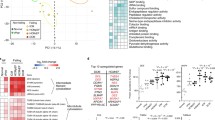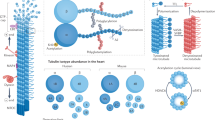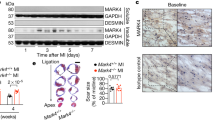Abstract
Cardiac microtubule stability is increased in the streptozotocin (STZ) model of type 1 diabetes. Here, we investigate the reason for increased microtubule stability, and the functional consequences of stable microtubule disruption. Ventricular myocytes were isolated from rats at 8–12 weeks after injection of STZ. A 10% increase in microtubule density, but no difference in the ratio of microtubule-associated protein 4 (MAP4) to tubulin was seen in myocytes from STZ rats. Functionally, STZ myocytes showed a tendency for reduced shortening and intracellular Ca2+ ([Ca2+] i ) transient amplitude, and a significant prolongation of time to peak (ttp) shortening and [Ca2+] i . Although microtubules in STZ myocytes were less sensitive to the microtubule disruptor nocodazole (NOC; 33 μM) than control myocytes, we only saw marked functional consequences of microtubule disruption by NOC in myocytes from diabetic animals. NOC increased shortening and [Ca2+] i transient amplitude in STZ myocytes by 45 and 24%, respectively (compared with 4 and 6% in controls). Likewise, NOC decreased ttp shortening and [Ca2+] i only in STZ myocytes, such that these parameters were no longer different between the two groups. In conclusion, stable microtubules in diabetes are not associated with an increase in MAP4, but are functionally relevant to cardiac dysfunction in diabetes, regulating both [Ca2+] i and shortening.
Similar content being viewed by others
References
Garcia MJ, McNamara PM, Gordon T, Kannel WB (1974) Morbidity and mortality in diabetics in the Framingham population. Sixteen year follow-up study. Diabetes 23:105–111
Galderisi M, Anderson KM, Wilson PW, Levy D (1991) Echocardiographic evidence for the existence of a distinct diabetic cardiomyopathy (the Framingham Heart Study). Am J Cardiol 68:85–89
Ahmed SS, Jaferi GA, Narang RM, Regan TJ (1975) Preclinical abnormality of left ventricular function in diabetes mellitus. Am Heart J 89:153–158
Rodrigues B, Cam MC, McNeill JH (1995) Myocardial substrate metabolism: implications for diabetic cardiomyopathy. J Mol Cell Cardiol 27:169–179
Goldstein MA, Entman ML (1979) Microtubules in mammalian heart muscle. J Cell Biol 80:183–195
Wordman L, Mitchison TJ (2005) Dynamics of microtubule assembly. In: Hyams JS, Lloyd CW (eds) Microtubules. Wiley Liss Inc., New York p 287
Howarth FC, Calaghan SC, Boyett MR, White E (1999) Effect of the microtubule polymerizing agent taxol on contraction, Ca2+ transient and L-type Ca2+ current in rat ventricular myocytes. J Physiol 516(Pt 2):409–419
Johnson BD, Byerly L (1994) Ca2+ channel Ca(2+)-dependent inactivation in a mammalian central neuron involves the cytoskeleton. Pflugers Arch 429:14–21
Rasenick MM, Stein PJ, Bitensky MW (1981) The regulatory subunit of adenylate cyclase interacts with cytoskeletal components. Nature 294:560–562
McLean WG, Cullum NA, Casson IF (1992) Clinical and experimental diabetes are associated with an impairment of peripheral nerve function. Exp Clin Endocrinol 99:116
Scott JN, Clark AW, Zochodne DW (1999) Neurofilament and tubulin gene expression in progressive experimental diabetes: failure of synthesis and export by sensory neurons. Brain 122(Pt 11):2109–2118
Cooper G (2000) Cardiocyte cytoskeleton in hypertrophied myocardium. Heart Fail Rev 5:187–201
Howarth FC, Qureshi MA, White E, Calaghan SC (2002) Cardiac microtubules are more resistant to chemical depolymerisation in streptozotocin-induced diabetes in the rat. Pflugers Arch 444:432–437
Schulze E, Kirschner M (1987) Dynamic and stable populations of microtubules in cells. J Cell Biol 104:277–288
Calaghan S, White E, Le Guennec JY (2001) A unifying mechanism for the role of microtubules in the regulation of [Ca2+]i and contraction in the cardiac myocyte. Circ Res 89:E31
Webster DR, Patrick DL (2000) Beating rate of isolated neonatal cardiomyocytes is regulated by the stable microtubule subset. Am J Physiol Heart Circ Physiol 278:H1653–H1661
Battell ML, Rodrigues B, Yuen VG, McNeill JH: Treatment and pharmacological interventions in streptozotocin diabetes. In: JH McNeill (ed), Experimental Models of Diabetes. CRC Press, FL, 2005, p. 195
Baandrup U, Ledet T, Rasch R (1981) Experimental diabetic cardiopathy preventable by insulin treatment. Lab Invest 45:169–173
Calaghan SC, White E, Colyer J (1998) Co-ordinated changes in cAMP, phosphorylated phospholamban, Ca2+ and contraction following beta-adrenergic stimulation of rat heart. Pflugers Arch 436:948–956
Howarth FC, Jacobson M, Shafiullah M, Adeghate E (2005) Long-term effects of streptozotocin-induced diabetes on the electrocardiogram, physical activity and body temperature in rats. Exp Physiol 90:827–835
Hatcher CJ, Godt RE, Nosek TM (1999) Excessive microtubules are not responsible for depressed force per cross-bridge in cardiac neural-crest-ablated embryonic chick hearts. Pflugers Arch 438:307–313
Calaghan SC, Le Guennec JY, White E (2001) Modulation of Ca(2+) signaling by microtubule disruption in rat ventricular myocytes and its dependence on the ruptured patch-clamp configuration. Circ Res 88:E32–E37
Wang X, Li F, Campbell SE, Gerdes AM (1999) Chronic pressure overload cardiac hypertrophy and failure in guinea pigs: II. Cytoskeletal remodeling. J Mol Cell Cardiol 31:319–331
Takahashi M, Shiraishi H, Ishibashi Y, Blade KL, McDermott PJ, Menick DR, Kuppuswamy D, Cooper G (2003) Phenotypic consequences of beta1-tubulin expression and MAP4 decoration of microtubules in adult cardiocytes. Am J Physiol Heart Circ Physiol 285:H2072–H2083
Sato H, Nagai T, Kuppuswamy D, Narishige T, Koide M, Menick DR, Cooper G (1997) Microtubule stabilization in pressure overload cardiac hypertrophy. J Cell Biol 139:963–973
Fein FS, Kornstein LB, Strobeck JE, Capasso JM, Sonnenblick EH (1980) Altered myocardial mechanics in diabetic rats. Circ Res 47:922–933
Ishikawa T, Kajiwara H, Kurihara S (1999) Alterations in contractile properties and Ca2+ handling in streptozotocin-induced diabetic rat myocardium. Am J Physiol 277:H2185–H2194
Tamada A, Hattori Y, Houzen H, Yamada Y, Sakuma I, Kitabatake A, Kanno M (1998) Effects of beta-adrenoceptor stimulation on contractility, [Ca2+]i, and Ca2+ current in diabetic rat cardiomyocytes. Am J Physiol 274:H1849–H1857
Choi KM, Zhong Y, Hoit BD, Grupp IL, Hahn H, Dilly KW, Guatimosim S, Lederer WJ, Matlib MA (2002) Defective intracellular Ca(2+) signaling contributes to cardiomyopathy in Type 1 diabetic rats. Am J Physiol Heart Circ Physiol 283:H1398–H1408
Yu Z, Tibbits GF, McNeill JH (1994) Cellular functions of diabetic cardiomyocytes: contractility, rapid-cooling contracture, and ryanodine binding. Am J Physiol 266:H2082–H2089
Zile MR, Green GR, Schuyler GT, Aurigemma GP, Miller DC, Cooper G (2001) Cardiocyte cytoskeleton in patients with left ventricular pressure overload hypertrophy. J Am Coll Cardiol 37:1080–1084
Lagadic-Gossmann D, Buckler KJ, Le PK, Feuvray D (1996) Altered Ca2+ handling in ventricular myocytes isolated from diabetic rats. Am J Physiol 270:H1529–H1537
Tasaka K, Mio M, Izushi K (1991) Role of cytoskeletons on Ca2+ release from the intracellular Ca store of rat peritoneal mast cells. Skin Pharmacol 4(Suppl 1):43–55
Acknowledgment
This work was funded by the British Heart Foundation and by a travel bursary from the British Council (Abu Dhabi, U.A.E).
Author information
Authors and Affiliations
Corresponding author
Additional information
Holly Shiels and Anthony O’Connell are equal first authorship.
Rights and permissions
About this article
Cite this article
Shiels, H., O’Connell, A., Qureshi, M.A. et al. Stable microtubules contribute to cardiac dysfunction in the streptozotocin-induced model of type 1 diabetes in the rat. Mol Cell Biochem 294, 173–180 (2007). https://doi.org/10.1007/s11010-006-9257-9
Received:
Accepted:
Published:
Issue Date:
DOI: https://doi.org/10.1007/s11010-006-9257-9




